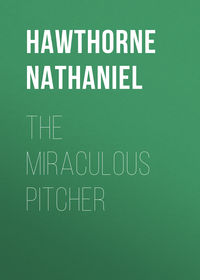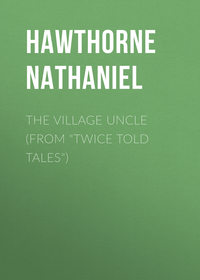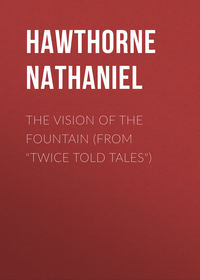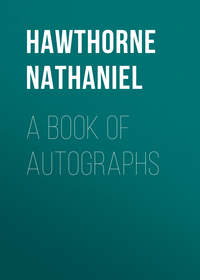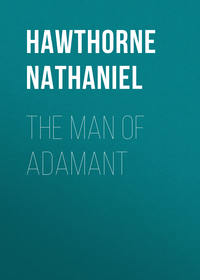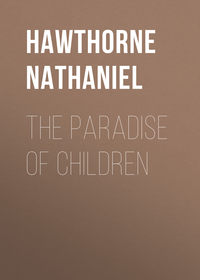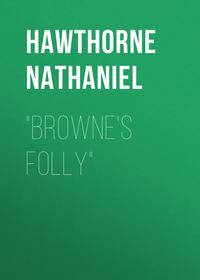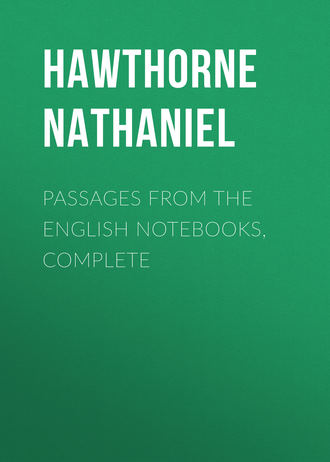 полная версия
полная версияPassages from the English Notebooks, Complete
Thus, too, the French Dauphin still exists, or a kind of ghost of him; the three Tells, too, in the cavern of Uri.
July 6th. – Mr. Cecil, the other day, was saying that England could produce as fine peaches as any other country. I asked what was the particular excellence of a peach, and he answered, "Its cooling and refreshing quality, like that of a melon!" Just think of this idea of the richest, most luscious, of all fruits! But the untravelled Englishman has no more idea of what fruit is than of what sunshine is; he thinks he has tasted the first and felt the last, but they are both alike watery. I heard a lady in Lord Street talking about the "broiling sun," when I was almost in a shiver. They keep up their animal heat by means of wine and ale, else they could not bear this climate.
July 19th. – A week ago I made a little tour in North Wales with Mr. Bright. We left Birkenhead by railway for Chester at two o'clock; thence for Bangor; thence by carriage over the Menai bridge to Beaumaris. At Beaumaris, a fine old castle, – quite coming up to my idea of what an old castle should be. A gray, ivy-hung exterior wall, with large round towers at intervals; within this another wall, the place of the portcullis between; and again, within the second wall the castle itself, with a spacious green court-yard in front. The outer wall is so thick that a passage runs in it all round the castle, which covers a space of three acres. This passage gives access to a chapel, still very perfect, and to various apartments in the towers, – all exceedingly dismal, and giving very unpleasant impressions of the way in which the garrison of the castle lived. The main castle is entirely roofless, but the hall and other rooms are pointed out by the guide, and the whole is tapestried with abundant ivy, so that my impression is of gray walls, with here and there a vast green curtain; a carpet of green over the floors of halls and apartments; and festoons around all the outer battlement, with an uneven and rather perilous foot-path running along the top. There is a fine vista through the castle itself, and the two gateways of the two encompassing walls. The passage within the wall is very rude, both underfoot and on each side, with various ascents and descents of rough steps, – sometimes so low that your head is in danger; and dark, except where a little light comes through a loophole or window in the thickness of the wall. In front of the castle a tennis-court was fitted up, by laying a smooth pavement on the ground, and casing the walls with tin or zinc, if I recollect aright. All this was open to the sky; and when we were there, some young men of the town were playing at the game. There are but very few of these tennis-courts in England; and this old castle was a very strange place for one.
The castle is the property of Sir Richard Bulkely, whose seat is in the
vicinity, and who owns a great part of the island of Anglesea, on which
Beaumaris lies. The hotel where we stopped was the Bulkely Arms, and Sir
Richard has a kind of feudal influence in the town.
In the morning we walked along a delightful road, bordering on the Menai Straits, to Bangor Ferry. It was really a very pleasant road, overhung by a growth of young wood, exceedingly green and fresh. English trees are green all about their stems, owing to the creeping plants that overrun them. There were some flowers in the hedges, such as we cultivate in gardens. At the ferry, there was a whitewashed cottage; a woman or two, some children, and a fisherman-like personage, walking to and fro before the door. The scenery of the strait is very beautiful and picturesque, and directly opposite to us lay Bangor, – the strait being here almost a mile across. An American ship from Boston lay in the middle of it. The ferry-boat was just putting off for the Bangor side, and, by the aid of a sail, soon neared the shore.
At Bangor we went to a handsome hotel, and hired a carriage and two horses for some Welsh place, the name of which I forget; neither can I remember a single name of the places through which we posted that day, nor could I spell them if I heard them pronounced, nor pronounce them if I saw them spelt. It was a circuit of about forty miles, bringing us to Conway at last. I remember a great slate-quarry; and also that many of the cottages, in the first part of our drive, were built of blocks of slate. The mountains were very bold, thrusting themselves up abruptly in peaks, – not of the dumpling formation, which is somewhat too prevalent among the New England mountains. At one point we saw Snowdon, with its bifold summit. We also visited the smaller waterfall (this is a translation of an unpronounceable Welsh name), which is the largest in Wales. It was a very beautiful rapid, and the guide-book considers it equal in sublimity to Niagara. Likewise there were one or two lakes which the guide-book greatly admired, but which to me, who remembered a hundred sheets of blue water in New England, seemed nothing more than sullen and dreary puddles, with bare banks, and wholly destitute of beauty. I think they were nowhere more than a hundred yards across. But the hills were certainly very good, and, though generally bare of trees, their outlines thereby were rendered the stronger and more striking.
Many of the Welsh women, particularly the older ones, wear black beaver hats, high-crowned, and almost precisely like men's. It makes them look ugly and witchlike. Welsh is still the prevalent language, and the only one spoken by a great many of the inhabitants. I have had Welsh people in my office, on official business, with whom I could not communicate except through an interpreter.
At some unutterable village we went into a little church, where we saw an old stone image of a warrior, lying on his back, with his hands clasped. It was the natural son (if I remember rightly) of David, Prince of Wales, and was doubtless the better part of a thousand years old. There was likewise a stone coffin of still greater age; some person of rank and renown had mouldered to dust within it, but it was now open and empty. Also, there were monumental brasses on the walls, engraved with portraits of a gentleman and lady in the costumes of Elizabeth's time. Also, on one of the pews, a brass record of some persons who slept in the vault beneath; so that, every Sunday, the survivors and descendants kneel and worship directly over their dead ancestors. In the churchyard, on a flat tombstone, there was the representation of a harp. I supposed that it must be the resting-place of a bard; but the inscription was in memory of a merchant, and a skilful manufacturer of harps.
This was a very delightful town. We saw a great many things which it is now too late to describe, the sharpness of the first impression being gone; but I think I can produce something of the sentiment of it hereafter.
We arrived at Conway late in the afternoon, to take the rail for Chester. I must see Conway, with its old gray wall and its unrivalled castle, again. It was better than Beaumaris, and I never saw anything more picturesque than the prospect from the castle-wall towards the sea. We reached Chester at 10 P. M. The next morning, Mr. Bright left for Liverpool before I was awake. I visited the Cathedral, where the organ was sounding, sauntered through the Rows, bought some playthings for the children, and left for home soon after twelve.
Liverpool, August 8th. – Visiting the Zoological Gardens the other day with J – , it occurred to me what a fantastic kind of life a person connected with them might be depicted as leading, – a child, for instance. The grounds are very extensive, and include arrangements for all kinds of exhibitions calculated to attract the idle people of a great city. In one enclosure is a bear, who climbs a pole to get cake and gingerbread from the spectators. Elsewhere, a circular building, with compartments for lions, wolves, and tigers. In another part of the garden is a colony of monkeys, the skeleton of an elephant, birds of all kinds. Swans and various rare water-fowl were swimming on a piece of water, which was green, by the by, and when the fowls dived they stirred up black mud. A stork was parading along the margin, with melancholy strides of its long legs, and came slowly towards its, as if for companionship. In one apartment was an obstreperously noisy society of parrots and macaws, most gorgeous and diversified of hue. These different colonies of birds and beasts were scattered about in various parts of the grounds, so that you came upon them unexpectedly. Also, there were archery and shooting-grounds, and a sewing. A theatre, also, at which a rehearsal was going on, – we standing at one of the doors, and looking in towards the dusky stage where the company, in their ordinary dresses, were rehearsing something that had a good deal of dance and action in it. In the open air there was an arrangement of painted scenery representing a wide expanse of mountains, with a city at their feet, and before it the sea, with actual water, and large vessels upon it, the vessels having only the side that would be presented to the spectator. But the scenery was so good that at a first casual glance I almost mistook it for reality. There was a refreshment-room, with drinks and cakes and pastry, but, so far as I saw, no substantial victual. About in the centre of the garden there was an actual, homely-looking, small dwelling-house, where perhaps the overlookers of the place live. Now this might be wrought, in an imaginative description, into a pleasant sort of a fool's paradise, where all sorts of unreal delights should cluster round some suitable personage; and it would relieve, in a very odd and effective way, the stern realities of life on the outside of the garden-walls. I saw a little girl, simply dressed, who seemed to have her habitat within the grounds. There was also a daguerreotypist, with his wife and family, carrying on his business in a shanty, and perhaps having his home in its inner room. He seemed to be an honest, intelligent, pleasant young man, and his wife a pleasant woman; and I had J – 's daguerreotype taken for three shillings, in a little gilded frame. In the description of the garden, the velvet turf, of a charming verdure, and the shrubbery and shadowy walks and large trees, and the slopes and inequalities of ground, must not he forgotten. In one place there was a maze and labyrinth, where a person might wander a long while in the vain endeavor to get out, although all the time looking at the exterior garden, over the low hedges that border the walks of the maze. And this is like the inappreciable difficulties that often beset us in life.
I will see it again before long, and get some additional record of it.
August 10th. – We went to the Isle of Man, a few weeks ago, where S – and the children spent a fortnight. I spent two Sundays with them.
I never saw anything prettier than the little church of Kirk Madden there. It stands in a perfect seclusion of shadowy trees, – a plain little church, that would not be at all remarkable in another situation, but is most picturesque in its solitude and bowery environment. The churchyard is quite full and overflowing with graves, and extends down the gentle slope of a hill, with a dark mass of shadow above it. Some of the tombstones are flat on the ground, some erect, or laid horizontally on low pillars or masonry. There were no very old dates on any of these stones; for the climate soon effaces inscriptions, and makes a stone of fifty years look as old as one of five hundred, – unless it be slate, or something harder than the usual red freestone. There was an old Runic monument, however, near the centre of the churchyard, that had some strange sculpture on it, and an inscription still legible by persons learned in such matters. Against the tower of the church, too, there is a circular stone, with carving on it, said to be of immemorial antiquity. There is likewise a tall marble monument, as much as fifty feet high, erected some years ago to the memory of one of the Athol family by his brother-officers of a local regiment of which he was colonel. At one of the side-entrances of the church, and forming the threshold within the thickness of the wall, so that the feet of all who enter must tread on it, is a flat tombstone of somebody who felt himself a sinner, no doubt, and desired to be thus trampled upon. The stone is much worn.
The structure is extremely plain inside and very small. On the walls, over the pews, are several monumental sculptures, – a quite elaborate one to a Colonel Murray, of the Coldstreamn Guards; his military profession being designated by banners and swords in marble. – Another was to a farmer.
On one side of the church-tower there was a little penthouse, or lean-to, – merely a stone roof, about three or four feet high, and supported by a single pillar, beneath which was once deposited the bier.
I have let too much time pass before attempting to record my impressions of the Isle of Man; but, as regards this church, no description can come up to its quiet beauty, its seclusion, and its every requisite for an English country church.
Last Sunday I went to Eastham, and, entering the churchyard, sat down on a tombstone under the yew-tree which has been known for centuries as the Great Tree of Eastham. Some of the village people were sitting on the graves near the door; and an old woman came towards me, and said, in a low, kindly, admonishing tone, that I must not let the sexton see me, because he would not allow any one to be there in sacrament-time. I inquired why she and her companions were there, and she said they were waiting for the sacrament. So I thanked her, gave her a sixpence, and departed. Close under the eaves, I saw two upright stones, in memory of two old servants of the Stanley family, – one over ninety, and the other over eighty years of age.
August 12th. – J – and I went to Birkenhead Park yesterday. There is a large ornamental gateway to the Park, and the grounds within are neatly laid out, with borders of shrubbery. There is a sheet of water, with swans and other aquatic fowl, which swim about, and are fed with dainties by the visitors. Nothing can be more beautiful than a swan. It is the ideal of a goose, – a goose beautified and beatified. There were not a great many visitors, but some children were dancing on the green, and a few lover-like people straying about. I think the English behave better than the Americans at similar places.
There was a camera-obscure, very wretchedly indistinct. At the refreshment-room were ginger-beer and British wines.
August 21st. – I was in the Crown Court on Saturday, sitting in the sheriff's seat. The judge was Baron – , an old gentleman of sixty, with very large, long features. His wig helped him to look like some strange kind of animal, – very queer, but yet with a sagacious, and, on the whole, beneficent aspect. During the session some mischievous young barrister occupied himself with sketching the judge in pencil; and, being handed about, it found its way to me. It was very like and very laughable, but hardly caricatured. The judicial wig is an exceedingly odd affair; and as it covers both ears, it would seem intended to prevent his Lordship, and justice in his person, from hearing any of the case on either side, that thereby he may decide the better. It is like the old idea of blindfolding the statue of Justice.
It seems to me there is less formality, less distance between the judge, jury, witnesses, and bar, in the English courts than in our own. The judge takes a very active part in the trial, constantly asking a question of the witness on the stand, making remarks on the conduct of the trial, putting in his word on all occasions, and allowing his own sense of the matter in hand to be pretty plainly seen; so that, before the trial is over, and long before his own charge is delivered, he must have exercised a very powerful influence over the minds of the jury. All this is done, not without dignity, yet in a familiar kind of way. It is a sort of paternal supervision of the whole matter, quite unlike the cold awfulness of an American judge. But all this may be owing partly to the personal characteristics of Baron – . It appeared to me, however, that, from the closer relations of all parties, truth was likely to be arrived at and justice to be done. As an innocent man, I should not be afraid to be tried by Baron – .
EATON HALL
August 24th. – I went to Eaton Hall yesterday with my wife and Mr. G. P. Bradford, via Chester. On our way, at the latter place, we visited St. John's Church. It is built of the same red freestone as the cathedral, and looked exceedingly antique, and venerable; this kind of stone, from its softness, and its liability to be acted upon by the weather, being liable to an early decay. Nevertheless, I believe the church was built above a thousand years ago, – some parts of it, at least, – and the surface of the tower and walls is worn away and hollowed in shallow sweeps by the hand of Time. There were broken niches in several places, where statues had formerly stood. All, except two or three, had fallen or crumbled away, and those which remained were much damaged. The face and details of the figure were almost obliterated. There were many gravestones round the church, but none of them of any antiquity. Probably, as the names become indistinguishable on the older stones, the graves are dug over again, and filled with new occupants and covered with new stones, or perhaps with the old ones newly inscribed.
Closely connected with the church was the clergyman's house, a comfortable-looking residence; and likewise in the churchyard, with tombstones all about it, even almost at the threshold, so that the doorstep itself might have been a tombstone, was another house, of respectable size and aspect. We surmised that this might be the sexton's dwelling, but it proved not to be so; and a woman, answering our knock, directed us to the place where he might be found. So Mr. Bradford and I went in search of him, leaving S – seated on a tombstone. The sexton was a jolly-looking, ruddy-faced man, a mechanic of some sort, apparently, and he followed us to the churchyard with much alacrity. We found S – standing at a gateway, which opened into the most ancient, and now quite ruinous, part of the church, the present edifice covering much less ground than it did some centuries ago. We went through this gateway, and found ourselves in an enclosure of venerable walls, open to the sky, with old Norman arches standing about, beneath the loftiest of which the sexton told us the high altar used to stand. Of course, there were weeds and ivy growing in the crevices, but not so abundantly as I have seen them elsewhere. The sexton pointed out a piece of a statue that had once stood in one of the niches, and which he himself, I think, had dug up from several feet below the earth; also, in a niche of the walls, high above our heads, he showed us an ancient wooden coffin, hewn out of a solid log of oak, the hollow being made rudely in the shape of a human figure. This too had been dug up, and nobody knew how old it was. While we looked at all this solemn old trumpery, the curate, quite a young man, stood at the back door of his house, elevated considerably above the ruins, with his young wife (I presume) and a friend or two, chatting cheerfully among themselves. It was pleasant to see them there. After examining the ruins, we went inside of the church, and found it a dim and dusky old place, quite paved over with tombstones, not an inch of space being left in the aisles or near the altar, or in any nook or corner, uncovered by a tombstone. There were also mural monuments and escutcheons, and close against the wall lay the mutilated statue of a Crusader, with his legs crossed, in the style which one has so often read about. The old fellow seemed to have been represented in chain armor; but he had been more battered and bruised since death than even during his pugnacious life, and his nose was almost knocked away. This figure had been dug up many years ago, and nobody knows whom it was meant to commemorate.
The nave of the church is supported by two rows of Saxon pillars, not very lofty, but six feet six inches (so the sexton says) in diameter. They are covered with plaster, which was laid on ages ago, and is now so hard and smooth that I took the pillars to be really composed of solid shafts of gray stone. But, at one end of the church, the plaster had been removed from two of the pillars, in order to discover whether they were still sound enough to support the building; and they prove to be made of blocks of red freestone, just as sound as when it came from the quarry; for though this stone soon crumbles in the open air, it is as good as indestructible when sheltered from the weather. It looked very strange to see the fresh hue of these two pillars amidst the dingy antiquity of the rest of the structure.
The body of the church is covered with pews, the wooden enclosures of which seemed of antique fashion. There were also modern stoves; but the sexton said it was very cold there, in spite of the stoves. It had, I must say, a disagreeable odor pervading it, in which the dead people of long ago had doubtless some share, – a musty odor, by no means amounting to a stench, but unpleasant, and, I should think, unwholesome. Old wood-work, and old stones, and antiquity of all kinds, moral and physical, go to make up this smell. I observed it in the cathedral, and Chester generally has it, especially under the Rows. After all, the necessary damp and lack of sunshine, in such a shadowy old church as this, have probably more to do with it than the dead people have; although I did think the odor was particularly strong over some of the tombstones. Not having shillings to give the sexton, we were forced to give him half a crown.
The Church of St. John is outside of the city walls. Entering the East gate, we walked awhile under the Rows, bought our tickets for Eaton Hall and its gardens, and likewise some playthings for the children; for this old city of Chester seems to me to possess an unusual number of toy-shops. Finally we took a cab, and drove to the Hall, about four miles distant, nearly the whole of the way lying through the wooded Park. There are many sorts of trees, making up a wilderness, which looked not unlike the woods of our own Concord, only less wild. The English oak is not a handsome tree, being short and sturdy, with a round, thick mass of foliage, lying all within its own bounds. It was a showery day. Had there been any sunshine, there might doubtless have been many beautiful effects of light and shadow in these woods. We saw one or two herds of deer, quietly feeding, a hundred yards or so distant. They appeared to be somewhat wilder than cattle, but, I think, not much wilder than sheep. Their ancestors have probably been in a half-domesticated state, receiving food at the hands of man, in winter, for centuries. There is a kind of poetry in this, quite as much as if they were really wild deer, such as their forefathers were, when Hugh Lupus used to hunt them.
Our miserable cab drew up at the steps of Eaton Hall, and, ascending under the portico, the door swung silently open, and we were received very civilly by two old men, – one, a tall footman in livery; the other, of higher grade, in plain clothes. The entrance-hall is very spacious, and the floor is tessellated or somehow inlaid with marble. There was statuary in marble on the floor, and in niches stood several figures in antique armor, of various dates; some with lances, and others with battle-axes and swords. There was a two-handed sword, as much as six feet long; but not nearly so ponderous as I have supposed this kind of weapon to be, from reading of it. I could easily have brandished it.
I don't think I am a good sight-seer; at least, I soon get satisfied with looking at the sights, and wish to go on to the next.
The plainly dressed old man now led us into a long corridor, which goes, I think, the whole length of the house, about five hundred feet, arched all the way, and lengthened interminably by a looking-glass at the end, in which I saw our own party approaching like a party of strangers. But I have so often seen this effect produced in dry-goods stores and elsewhere, that I was not much impressed. There were family portraits and other pictures, and likewise pieces of statuary, along this arched corridor; and it communicated with a chapel with a scriptural altar-piece, copied from Rubens, and a picture of St. Michael and the Dragon, and two, or perhaps three, richly painted windows. Everything here is entirely new and fresh, this part having been repaired, and never yet inhabited by the family. This brand-newness makes it much less effective than if it had been lived in; and I felt pretty much as if I were strolling through any other renewed house. After all, the utmost force of man can do positively very little towards making grand things or beautiful things. The imagination can do so much more, merely on shutting one's eyes, that the actual effect seems meagre; so that a new house, unassociated with the past, is exceedingly unsatisfactory, especially when you have heard that the wealth mud skill of man has here done its best. Besides, the rooms, as we saw them, did not look by any means their best, the carpets not being down, and the furniture being covered with protective envelopes. However, rooms cannot be seen to advantage by daylight; it being altogether essential to the effect, that they should be illuminated by artificial light, which takes them somewhat out of the region of bare reality. Nevertheless, there was undoubtedly great splendor, for the details of which I refer to the guide-book. Among the family portraits, there was one of a lady famous for her beautiful hand; and she was holding it up to notice in the funniest way, – and very beautiful it certainly was. The private apartments of the family were not shown us. I should think it impossible for the owner of this house to imbue it with his personality to such a degree as to feel it to be his home. It must be like a small lobster in a shell much too large for him.


